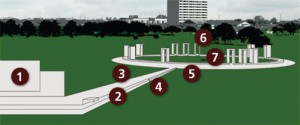Memorial Design
The Bonfire Memorial comprises three sections, each evoking a particular aspect of the Aggie Bonfire: tradition, history and spirit. Each section and description corresponds to its respective number in the graphic above.
1. Visitors enter the memorial at Tradition Plaza, whose vertical wall serve as a barrier between the peace and intimacy of the memorial and the outside world. The wall is engraved with The Last Corps Trip, the poem traditionally recited before the lighting of each year’s Bonfire; the view above the lower wall draws visitors into the memorial via History Walk.
2. Each of the 89 granite blocks along History Walk represents a year in which Bonfire burned between 1909 and 1998. Notches cut at a point 11/12ths of each stone’s width represent November, the 11th month of the year and the month in which Bonfire burned. Amber lights set within the notches illuminate the walk at night, symbolizing the burning Bonfire.
3. Blocks representing 1955, 1982 and 1996 include bronze plaques memorializing students killed in Bonfire-related accidents in those years.
4. A black slab marks the year 1963, the year the Bonfire stack was disassembled, log-by-log, after President John F. Kennedy’s assassination.
5. Twenty-seven granite blocks, connected by 12 portals, form the Spirit Ring, whose 170-foot diameter recreates the perimeter fence erected each year around the Bonfire stack. Bronze plaques set into each of the blocks represent the 27 Aggies injured in the 1999 collapse, yet they are left blank in recognition of all who were injured during Bonfire’s 90-year history.
6. The interior of the Spirit Ring may be accessed through 12 portals, one for each Aggie lost in 1999. The outer, granite, portals stand 16 feet tall; and the interior, bronze, portals 12 feet. Each is on a line extending from the center of the ring to the hometown of the Aggie represented, and the bronze portal is engraved with three memorial elements – a portrait, his or her signature and a written reflection.
7. At the ring’s center is a black-granite marker, 18 inches in diameter, representing the Bonfire stack’s Centerpole. Positioned on the exact spot used for Centerpole, the marker is engraved with the date and time of the collapse: 11-18-1999 2:42 a.m.

